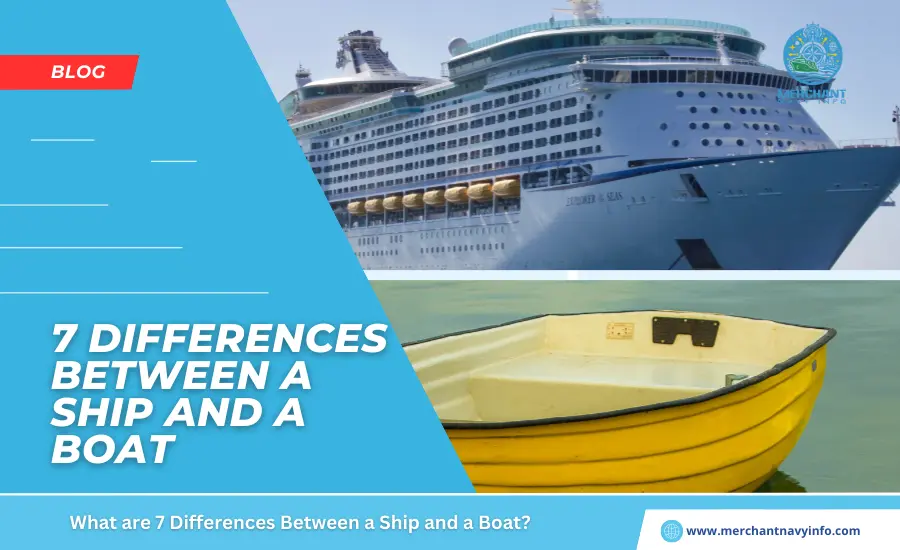
Everyone knows the difference between in a ship and a boat, but many people often confuse the two terms. Technically speaking, there is a fine line between them, which often leads to a lot of confusion. When you think of the difference between boat vs ship, the first thing that comes to mind is their size. Traditionally, ships are considered large ocean-going vessels, whereas boats are relatively small. To understand the difference between a ship and a boat, several aspects need to be considered. Below are the seven main aspects considered when differentiating between ships and boats.
Ship Specifications
“Dispatch details change incredibly depending on the sort and reason of the vessel. By and large, determinations incorporate subtle elements such as the ship’s measurements, tonnage, drive framework, greatest speed, fuel capacity, and extend. For maritime vessels, extra determinations may incorporate combat hardware, cautious frameworks, and stealth capabilities. Cargo ships ordinarily list cargo capacity, stacking instruments, and refrigeration capabilities. Journey ships highlight traveler capacity, conveniences like eateries and excitement settings, and security highlights such as rafts and departure strategies. Also, natural affect components like emanations and squander administration are progressively vital in present day transport determinations, reflecting a developing accentuation on maintainability inside the sea industry.”
Boat Specifications
Watercraft details include a run of subtle elements depending on the sort and reason of the watercraft. For the most part, they incorporate measurements such as length, width, and draft, as well as weight or relocation. Drive strategies, whether cruise, motor, or both, are point by point at the side motors determinations like drive, fuel sort, and fuel capacity. For sailboats, subtle elements are given, such as pole stature, cruise zone, and fixing. Security highlights such as life-saving hardware, route helps, and communication frameworks are pivotal angles of details. Moreover, inside highlights like cabin format, billets, civilities, and capacity are frequently included, especially for recreational vessels. Finally, administrative compliance and certification, such as adherence to oceanic benchmarks and controls, may also be indicated.
Difference Between Boat And Ship
1. Size of Ships and Boats
The most important aspect considered when explaining the difference between ships and boats is size. The best way to distinguish between boat vs ship is: “A ship can carry a boat, but a boat cannot carry a ship.” Technically, a waterborne vehicle weighs at least. Items over 500 tons are classified as ships. In comparison, boats are very compact in size and displacement.
2. Field of Application
The main difference between boat vs ship lies in the field of application. Ships are vessels operating in the maritime domain and on the high seas. These typically include cruise ships, naval vessels, tankers, container ships, RoRo vessels, and ocean vessels. These are primarily made for transporting cargo/passengers across oceans. Meanwhile, boats are used in small/confined waters and include ferries, tugs, sailboats, paddle steamers, kayaks, canoes, and patrol boats. Boats are primarily used for small purposes and operate primarily in coastal areas.
3. Navigation and Technology
Technically speaking boat vs ship, a boat is a simple vessel with less complex equipment, systems, and operational and maintenance requirements. Because ships must operate for long periods of time and travel across oceans, they are equipped with advanced technology, heavy machinery, and navigation systems.
4. Crew
This is one of the main differences between a ship and a boat. Because the ships are large, they are controlled by professionally trained navigators and engineers. A ship needs a captain to steer the ship and guide the crew. On the other hand, the size of a boat’s crew depends on the size of the boat. Depending on the size and purpose of the boat, it may have a crew of 1 or 1 person.
5. Cargo Capacity
A boat is a small to medium-sized vessel that can carry much less cargo than a ship. Ships are specifically designed to transport cargo, passengers, or boats, but “boat” is a general term for a variety of vessels. boats are mainly used for leisure purposes, fishing, and ferry transport.
6. Construction and Design
When it comes to construction and design, a ship is a complex structure with various mechanical systems that must be designed with the safety and stability of the ship in mind. The boat is much simpler in design and construction, with less mechanical and design complexity.
7. Propulsion
Boats can be propelled by sails, motors, or human power, but ships have special engines for propulsion. (Ships may also be propelled by sails or other advanced propulsion techniques.) All vessels operating on the high seas are called ships, but submersible vessels are commonly referred to as “boats.” This is mainly because, centuries ago, submersibles were hoisted onto ships until they were used at sea. However, when talking about the difference between a ship and a boat, we are mainly considering vessels that float on the water’s surface.
The use of the term “ship” or “boat” also varies depending on the region in which it is used. People in some countries refer to medium-sized fishing boats as boats and medium-sized ferries and leisure boats as ships. As you can see, people tend to generalize containers based on their size. Note, however, that the difference between a ship and a boat depends on many factors, as explained above.










